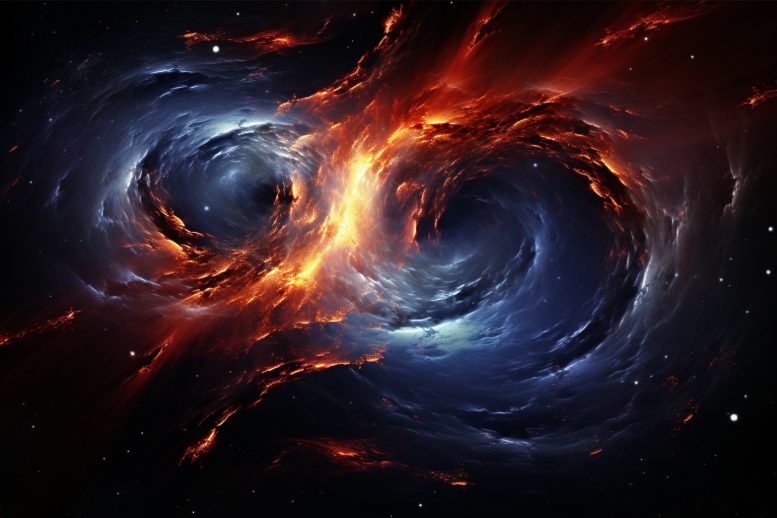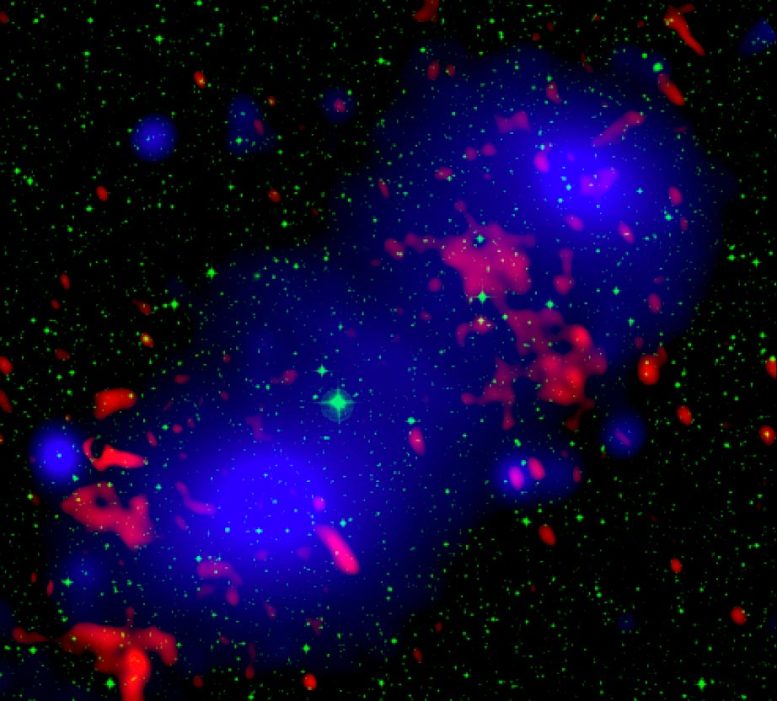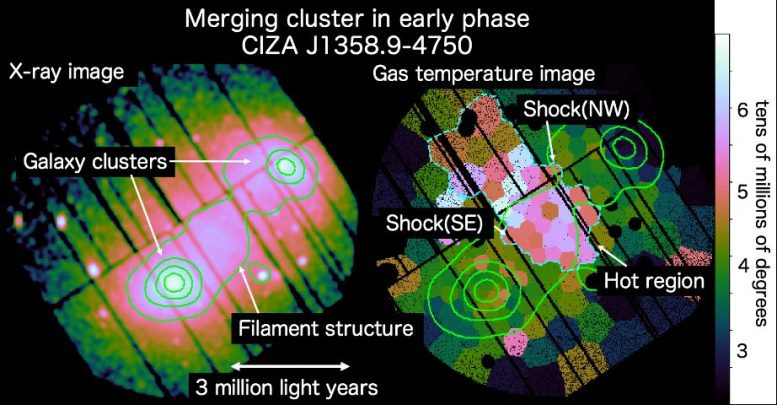
An international team of researchers has successfully estimated the size and merging velocity of a shock wave in a merging galaxy cluster, finding the energy released to be 2.3 × 1038 W. This achievement was made possible by capitalizing on a recent cluster collision, which facilitated the complex measurement of celestial objects. (Artist’s concept.)
A team of researchers led by Associate Professor Kazuhiro Nakazawa from Nagoya University/KMI and doctoral student Yuki Omiya at the Graduate School of Science has made significant strides in understanding galaxy clusters. Collaborating with esteemed institutions like the National Astronomical Observatory of Japan, Tokyo University of Science, Hiroshima University, Saitama University, JAXA Institute of Space and Astronautical Science, Tokyo Metropolitan University, Netherlands Institute for Space Sciences, and Toho University, they have been successful in estimating the dimensions and merging velocity of a newborn shock wave in the proximate merging galaxy cluster CIZA J1358.9-4750. This endeavor has also allowed them to gauge the energy released, an astounding 2.3 × 1038 W. The data for this research was obtained from the European X-ray astronomy satellite XMM-Newton.

Recently merging galaxy cluster CIZA J1358.9-4750. Credit: Nagoya University
Galaxy Clusters and Their Significance
Galaxy clusters, known as the largest self-gravitating objects in the universe, are home to a vast expanse of high-temperature gas. This gas emits brilliant X-rays, making these clusters visible. When these colossal clusters merge, it culminates in an astronomical event of unmatched magnitude, spawning a shock wave spanning 3 million light-years square.

Images of X-ray intensity (left) and temperature (right) of the recently merging galaxy cluster CIZA1359. Credit: Nagoya University
The Complex Measurement of Astronomical Objects
Typically in astronomy, measuring the depth of celestial objects poses a significant challenge. However, in this study, the team surmounted this difficulty by capitalizing on the recent collision of the two clusters. This event made it possible to make reasonable estimates about the original shape of the clusters. Using these estimates, they determined the velocity of the shock front by analyzing the temperature distribution of the high-temperature gas. They then multiplied this value by the length, width, and depth of the clusters to calculate the amount of kinetic energy being converted into heat, particle acceleration, and magnetic-field amplification in the shock front.
This research was published in the February 2023 issue of the Publications of the Astronomical Society of Japan (PASJ). In a related paper, Kurahara et al. (PASJ, December 2022) discovered “synchrotron radio emission” by accelerated electrons and amplificated magnetic fields around the shock front. Its luminosity is estimated to be ~3.5 × 1033 W. These results give us a conversion efficiency of about 10-5.
Understanding the distribution of conversion efficiency will help us to clarify what is happening under the largest shock wave in the cluster merger.
Reference: “XMM-Newton view of the shock heating in an early merging cluster, CIZA J1358.9−4750” by Yuki Omiya, Kazuhiro Nakazawa, Kyoko Matsushita, Shogo B Kobayashi, Nobuhiro Okabe, Kosuke Sato, Takayuki Tamura, Yutaka Fujita, Liyi Gu, Tetsu Kitayama, Takuya Akahori, Kohei Kurahara and Tomohiro Yamaguchi, 1 December 2022, Publications of the Astronomical Society of Japan.
DOI: 10.1093/pasj/psac087
"flow" - Google News
July 24, 2023 at 06:48AM
https://ift.tt/XubpHWr
Unleashing Cosmic Power: Energy Flow in the Universe's Largest Shock Waves - SciTechDaily
"flow" - Google News
https://ift.tt/Y2xT4Go
https://ift.tt/CAWYedU
Bagikan Berita Ini














0 Response to "Unleashing Cosmic Power: Energy Flow in the Universe's Largest Shock Waves - SciTechDaily"
Post a Comment